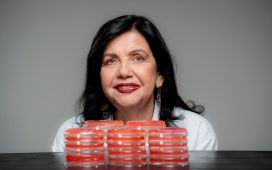
Paul Taylor
Image source: NPCC
Interview: Professor Paul Taylor outlines the priorities and emphasises the need to ‘democratise the science’ for police officers
A strategy is in place for science and technology in policing, and now it’s about delivery for police forces. This is how Professor Paul Taylor sums up the outlook in his job as chief scientific adviser for policing.
The National Police Chiefs’ Council (NPCC) announced two significant moves last month, with the formation of a science and technology committee and a new direction in Taylor’s role. He conveys it more as a continuation, but with a shift in focus.
He says the first two years has been about developing the Strategy for Science and Technology in Policing, and that the emphasis, working with the committee, is now on delivering the strategy throughout police forces.
“I truly believe that science and innovation offer a huge amount of efficiency gains for policing and better service for the public,” he says. “The scientific adviser is there as an independent person to make sure we deliver to the best effect.”
The announcement has prompted the question of how the work will sit alongside that of the Police Digital Service (PDS), which develops and manages digital services for the sector.
Synergetic relationship
“Our relationship is quite synergetic,” Taylor responds. “PDS is largely focused on delivery, and science and innovation is largely focused on the future and the challenges that might come down the line that could affect delivery.
“We work with PDS to consider some of those and what opportunities might be coming down the line, and to ensure they can be delivered to a national level. We do work very closely together and they dovetail quite nicely.”
He also says that only about 30% of his role is focused on digital, data and technology, and he has an interest in other issues, as varied as the role of police dogs and the next generation of uniforms, beyond the PDS remit.
Asked about priorities for the next few months, he says they are being determined by the recently published Policing Productivity Review, which includes a section on ‘technology as a productivity multiplier’ and highlights the need for a step change in the relevant work.
“One of the things the review picks out is that we are sitting on what I would call a huge innovation of intellectual property,” he says. “Through a review process of 63 innovations in policing we found that if we were to scale them up nationally we would have £352 million of cost savings and 15 million hours of officer time back.
“I think that’s fantastic that we are sitting on that intellectual property already; we’ve done it and now have to encourage its adoption across the country.
“Along with those figures is the complexity of policing – not every force will want to adopt every innovation – but I think it begins to show the kind of opportunity that is there. A lot of our work will be helping forces go through that catalogue.”
Investments in priorities
This will be accompanied by encouraging strategic investments in areas identified as priorities, working on the technologies and processes that could be delivered in a more joined up way. Taylor says this involves a “conveyor belt” approach, not rushing things as police forces only have the capacity to take on three or four innovations per year, needing time to ingest them and get the skills and policies in place.
The initial emphasis is on increasing the take-up of retrospective facial recognition technology – in line with Home Office policy – and encouraging the use of automated text redaction by police forces to populate case files.
“Next year we are also looking at multimedia redaction,” adds. “We get a lot of subject access requests for body-worn video – the public has a right to see the video – but in those cases we have to blur the faces of other people.
“That can take a lot of time if you are doing it manually, but AI is now able to recognise faces with significant accuracy so we are now looking to automate the process. A member of staff would look to see that it is doing what it should do prior to releasing the video.
“Then you have things a bit further out of field, like beyond visual line of sight in the use of drones, allowing us to use drones in things such as response to emergencies in rural areas, where we are trying to get there much faster for intelligence gathering to send the right support. And other areas such as using the drones for public events to keep people safe.
“This is longer term, as we need to make sure the public are comfortable with it and we can do it in a safe and controlled manner, but it is a priority.”
Looking further forward there are other possibilities that are not currently big in policing but have potential.
Knife detection
Taylor talks of combining sensors with AI to monitor people for knives while ensuring that any metal detected is not pocket clutter. This would be a big asset in reducing the number of body searches for weapons that reveal nothing – which could reduce tensions between the police and some groups within communities.
He also points to the collection of environmental DNA, using sensors to detect and collect minute particles at a crime scene. Breakthroughs with the technology are being made in other sectors and he says this could be important for police forensics in a few years.
It all raises another question around the capacity of police forces to take on new technologies, especially when they demand a completely different skillset.
Taylor says there is a very positive attitude towards innovation, and acknowledges that the need for training will always be there. There will always be a need for specialists to handle the more complex tasks, but this has to come with another approach.
“What you really need to start doing is democratise the science,” he says. “You have some great examples of this. In Essex Constabulary they have utilised Microsoft technology to allow all officers access to their crime data, so they can now take a data driven approach to how they do their shifts.
“It’s understanding what offences have happened and where, what that might mean for how they distribute their resources. It no longer needs to rely on the analyst; anyone who wants to understand their job can go in and use it.
“Then there’s something called rapid DNA, a system that allows almost anybody to do a DNA trace within 30 minutes. That was already touted as great because of the speed with which it worked, but I think the real value is that anybody can do it. It’s not evidential so you would always have to do a proper DNA test in a lab, but if it provided a negative I could let you go very quickly.
“The value is that it is democratising who can use the science. It’s allowing more people to use it.”
Sharing and interoperability
Taylor also sees plenty of scope for sharing the resources among police forces, pointing out that PDS is delivering services, there are regional initiatives for functions such as forensics and the beginnings of sharing facial recognition capabilities.
“And the interoperability of the various systems is critical. It is increasingly common for systems to be interoperable. We’ve had lots of conversations with industry around making sure that’s their norm. So even if forces adopt different systems they can talk to each other.”
He also has an eye on developments elsewhere in the world, pointing to the recently established International Police Research and Innovation Network, in which specialists from the UK, US, Canada, Australia and New Zealand are sharing their work.
“There is a growing interconnectivity,” he says. “If it has been developed somewhere else in the world why shouldn’t we be using it and sharing it? I think there is an appetite to do that.”
Amid the future gazing, Taylor keeps the perspective rooted in making clear that the value of the work is in supporting police officers in the field. While there is currently a programme to get more of them on the streets, they will need technology that enables them to respond to incidents quickly and effectively.
“We’ve had the Police Uplift Programme to bring in 20,000 new officers, and I think there is a greater recognition that in order to make the most of those officers we need to give them the best kit and the best science and tech to enable them to do what they need to do. I think that comes through loud and clear in the productivity review, and I look forward to trying to deliver that to drive efficiency and ultimately deliver a better service for the public.”











